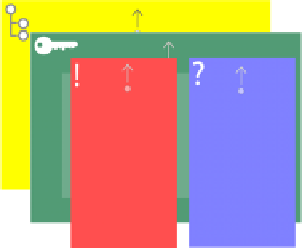Information Technology Reference
In-Depth Information
object
, as the physical bookmark represents the actual tag. Since the bookmark is
visible on paper, full visual feedback is available without additional digital support.
Moreover, its shape provides a strong affordance for quickly accessing the physical
page which has been bookmarked. This is a clear advantage over other classification
means discussed in the literature (e.g. [75, 170]), which do not modify the physical
shape of the document.
However, it is precisely this advantage that makes it difficult to re-print a docu-
ment including the bookmarks. In order to address this problem with current tech-
nology, the print module prints a small image of the bookmark at each position of
the document where a bookmark was attached in the original document. This is a
visual indicator for the user who can then add bookmarking stickers at these posi-
tions. Clearly, this is a workaround which is not efficient when a document contains
a large number of bookmarks. Future printers could solve this problem by automat-
ically attaching bookmarking stickers at the appropriate positions while a document
is printed.
Semantic Types
In addition to free tagging with keywords, Digital Paper Bookmarks offer predefined
categories that support users in structuring documents. Users can choose between
different types, each represented by a specific color and a specific symbol.
Offering different types of bookmarks has two main advantages: First, some com-
mon semantic classes facilitate the computer interpretation of bookmarks, the shar-
ing with other users and automatic aggregations. Second, if bookmarks are used in a
learning setting, the availability of specific types can support meta-cognitive learn-
ing processes by encouraging and reminding users to perform specific important
learning activities which are related to bookmarking.
We developed a first set of semantic types to be used with Digital Paper Book-
marks in learning processes. It comprises four types. We distinguish the following
four types on two layers:
The two semantic types on the
structure layer
support learners in structuring
the learning documents: Section bookmarks (yellow) mark the beginning of a new
Fig. 7.3
The current version
of CoScribe includes four
semantic types of bookmarks

